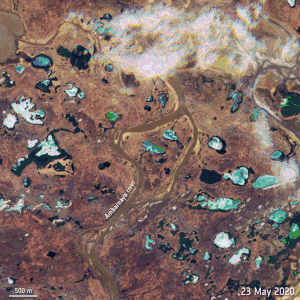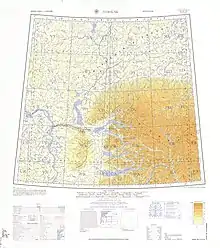Norilsk oil spill
The Norilsk diesel oil spill is an ongoing industrial disaster near Norilsk, Krasnoyarsk Krai, Russia. It began on 29 May 2020 when a fuel storage tank at Norilsk-Taimyr Energy's Thermal Power Plant No. 3 (owned by Nornickel) failed, flooding local rivers with up to 17,500 tonnes of diesel oil.[1][2] President Vladimir Putin declared a state of emergency in early June.[3] The incident has been described as the second-largest oil spill in modern Russian history, after the 1994 Komi pipeline spill,[4][5] where 400,000 tonnes of crude oil were released to the environment between August 1994 and January 1995.[6]
| Norilsk diesel oil spill | |
|---|---|
 Extent of the spill as seen by Sentinel-2 satellite | |

| |
| Location | Norilsk, Krasnoyarsk Krai, Russia |
| Coordinates | 69°22′46″N 87°44′40″E |
| Date | 29 May 2020 |
| Cause | |
| Cause |
|
| Operator | NTEK (Nornickel subsidiary) |
| Spill characteristics | |
| Volume | 21,000 m3 (17,500 tonnes)[1] |
| Area | 350 km2 (140 sq mi) |
Cause

Diesel oil is used as a backup fuel for the Norilsk-Taimyr Energy coal-fired combined heat and power plant.[7] Fuel storage Tank 5 failed due to holes at the tank bottom, caused by the formation of ulcerative corrosion.[8] In 2014 the company had been ordered by the Russian regulatory agency for natural resources Rostekhnadzor to, by 2015, clean the outer surface of the walls and roof of the tanks from rust and restore the anticorrosion coating, and by October 2016, to conduct non-destructive inspection of the tank bottoms. Despite these requests from the Russian Government, Norilsk-Taimyr Energy did not take the requested steps to avoid a failure of Tank 5.[9][10]
Spread and clean-up
Up to 21,000 cubic metres (17,500 tonnes) of diesel oil spilled on to the ground and into local rivers,[1] affecting an immediate area of 18 hectares (44 acres), the nearby Daldykan River, a tributary of the Ambarnaya River, and contaminating an area of 350 square kilometres (140 square miles). Clean-up efforts were anticipated to be difficult as there are no roads and the rivers are too shallow for boats and barges. It was estimated the immediate cost of emergency relief activities would be 10 billion roubles (US$146 million), with a total clean-up cost of 100 billion roubles (US$1.5 billion), which would take five to ten years; Norilsk Nickel is to pay the costs.[11][12]
On 4 June 2020 Russian state television reported that the spill had been contained using a series of specially constructed booms on the Ambarnaya river.[13] However, drifting ice broke the booms[14] and the spill reached Lake Pyasino, threatening the Pyasina River,[15] which flows into the Arctic Ocean.
Aftermath

Russia's Investigative Committee has launched a criminal investigation of the spill.[17]
The head of the power plant's boiler-turbine workshop was placed in pretrial detention, charged with violating environmental regulations and negligence.[14][18] Yevgeny Zinichev, head of Russia's Emergency Situations Ministry, stated that the power plant did not report the incident for two days, while trying to contain the situation on their own.[19] President Vladimir Putin declared a regional state of emergency following the spill, and criticized the local authorities for a slow response.[19] He also criticized Vladimir Potanin, chairman and major shareholder of Norilsk Nickel, for not properly maintaining the safety of the fuel tanks at the plant.[20] Putin ordered officials to amend Russian law to prevent similar accidents in the future.[21] In a 3 June 2020 televised meeting devoted to disaster management, Putin asked Sergei Lipin, the head of NTEK: "Why did government agencies only find out about this two days after the fact? Are we going to learn about emergency situations from social media?"[22][23]
After the state environmental agency Rosprirodnadzor told its employee Vasily Ryabinin to stop investigating the disaster, he quit his job on 7 June and went public as a whistleblower.[24]
In the aftermath of the Norilsk spill, Russia's Prosecutor General's office ordered safety checks at all dangerous installations built on the permafrost in Russia's Arctic.[25] Greenpeace Russia compared the potential environmental effects of the Norilsk spill to that of the 1989 Exxon Valdez oil spill.[19]
As a result of this incident, Oleg Deripaska, the founder of Rusal, which in 2019 owned 28% of Nornickel, urged management changes at Nornickel, which is 35% owned by billionaire businessman Vladimir Potanin's Olderfrey Holdings Ltd.[26][27]
See also
References
- "Diesel fuel spill in Norilsk in Russia's Arctic contained". TASS. Moscow, Russia. 5 June 2020. Archived from the original on 6 June 2020. Retrieved 6 June 2020.
- Max Seddon (4 June 2020), "Siberia fuel spill threatens Moscow's Arctic ambitions", Financial Times, archived from the original on 7 June 2020, retrieved 5 June 2020
- "Putin orders state of emergency after huge fuel spill inside Arctic Circle". The Guardian. 3 June 2020. Archived from the original on 3 June 2020. Retrieved 4 June 2020.
- "Putin slams mining company over massive Siberian diesel leak, declares state of emergency". RTÉ. Raidió Teilifís Éireann. AFP. 3 June 2020. Archived from the original on 11 June 2020. Retrieved 12 June 2020.
- Ivan Nechepurenko (5 June 2020), "Russia Declares Emergency After Arctic Oil Spill", New York Times, archived from the original on 5 June 2020, retrieved 5 June 2020
- Minerals Yearbook, Volume 3. Washington DC: US Bureau of Mines. 1995. p. 728. ISBN 978-1345966411. Archived from the original on 5 February 2021. Retrieved 14 June 2020.
- "Russia to fine legal entities violating security rules at fuel-and-energy facilities". TASS. 9 July 2020. Archived from the original on 13 September 2020. Retrieved 5 September 2020.
- "Norilsk oil spill: Tensions rise as Nornickel disputes extent of damage". Mining Technology. London. 9 July 2020. Archived from the original on 4 September 2020. Retrieved 5 September 2020.
- "Rostekhnadzor warned Norilsk Nickel about problems with fuel storage". Achyde. 5 June 2020. Archived from the original on 8 June 2020. Retrieved 8 June 2020.
- Weise, Elizabeth; Zaiets, Karina; Gelles, Karl (6 June 2020). "Russia declares state of emergency over Arctic Circle oil spill caused by melting permafrost". USA TODAY. Archived from the original on 6 June 2020. Retrieved 6 June 2020.
- "Norilsk Nickel to pay emergency relief costs, says Putin". TASS. Moscow. 5 June 2020. Archived from the original on 6 June 2020. Retrieved 6 June 2020.
- ,Russia's Putin declares state of emergency after Arctic Circle oil spill, BBC, 4 June 2020, archived from the original on 5 June 2020, retrieved 5 June 2020
- "Russian Power Plant Spills Thousands Of Tons Of Oil Into Arctic Region". NPR. 4 June 2020. Archived from the original on 6 June 2020. Retrieved 6 June 2020.
- "Arrest Made Over Massive Fuel Leak In Siberia". RFE/RL. Prague. 4 June 2020. Archived from the original on 8 June 2020. Retrieved 8 June 2020.
- "Fuel spilled near Russia's Norilsk gets into Lake Pyasino - governor". Interfax. 9 June 2020. Archived from the original on 9 June 2020. Retrieved 9 June 2020.
- Meeting on cleaning up diesel fuel leak in Krasnoyarsk Territory, Kremlin, 3 June 2020, archived from the original on 5 June 2020, retrieved 7 June 2020
- "Russia detains Arctic power station managers over massive 21,000-tonne fuel spill". 11 June 2020. Archived from the original on 10 June 2020. Retrieved 11 June 2020.
- "Head of CHPP-3 plant workshop detained in case of fuel spill in Norilsk". TASS. Moscow. 3 June 2020. Archived from the original on 5 June 2020. Retrieved 8 June 2020.
- Isabelle Khurshudyan (4 June 2020). "Arctic fuel spill prompts Russia's Putin to declare emergency and slam slow response". Washington Post. Archived from the original on 5 June 2020. Retrieved 6 June 2020.
- "Russia claims to have contained huge oil spill after Arctic river turns red". The Independent. 5 June 2020. Archived from the original on 6 June 2020. Retrieved 6 June 2020.
- "Putin chides Nornickel, orders law change after Arctic fuel spill". Reuters. 5 June 2020. Archived from the original on 5 June 2020. Retrieved 6 June 2020.
- Bodner, Matthew (5 June 2020). "Russia launches major clean-up operation after huge Arctic fuel spill". NBC News Digital. Archived from the original on 5 June 2020. Retrieved 6 June 2020.
- Kim, Lucian (4 June 2020). "Russian Power Plant Spills Thousands Of Tons Of Oil Into Arctic Region". NPR. Archived from the original on 8 June 2020. Retrieved 6 June 2020.
- Ilyushina, Mary (10 July 2020). "The Russian whistleblower risking it all to expose the scale of an Arctic oil spill catastrophe". CNN. Archived from the original on 11 July 2020. Retrieved 11 July 2020.
- "Arctic Circle oil spill: Russian prosecutors order checks at permafrost sites". BBC News. 5 June 2020. Archived from the original on 5 June 2020. Retrieved 6 June 2020.
- Russian Oligarchs Battle Over Nornickel’s Arctic Oil Spill Archived 3 September 2020 at the Wayback Machine, Forbes, 14 July 2020
- "Annual Report 2019 - Share Capital". Nornickel. 2020. Archived from the original on 13 September 2020. Retrieved 5 September 2020.
External links
 Media related to 2020 Norilsk oil spill at Wikimedia Commons
Media related to 2020 Norilsk oil spill at Wikimedia Commons